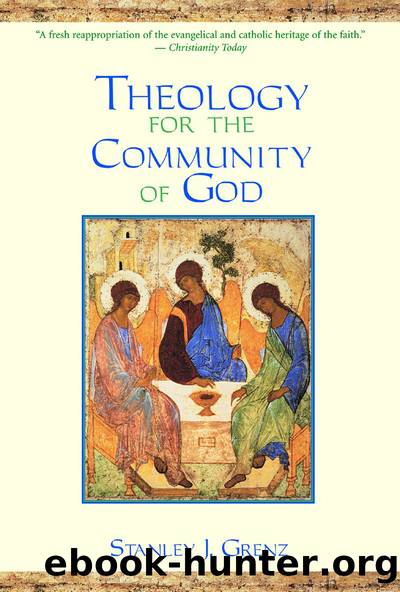Theology for the Community of God by Stanley J. Grenz

Author:Stanley J. Grenz
Language: eng
Format: epub
Publisher: Eerdmans
Published: 1994-03-15T00:00:00+00:00
CHAPTER 12
The Mission of Jesus
For this reason I was born, and for this I came into the world, to testify to the truth.
John 18:37
At the heart of the Christian faith is the confession that God is present in Jesus of Nazareth. In the previous three chapters, we explored the meaning of this confession for Jesusâ identity. We asserted that he reveals both true deity (chapter 9) and true humanity (chapter 10) in one personal life (chapter 11).
Jesusâ ministry is inherent in his identity. Theologians generally divide Christology into the related topics of âChristâs personâ and âChristâs work.â When so divided, which theme ought to precede the other? Reformed thinkers traditionally move from the person of Christ to his work in salvation, whereas Lutherans often begin with Christâs work as forming the foundation from which to understand his person.
In our Christology we have followed the basic Reformed approach, albeit with a major difference. Rather than the older nomenclature (âpersonâ and âworkâ), we prefer the designation âidentityâ and âmissionâ as lying closer to the Hebrew way of thinking that pervades the Bible. Although we move from Jesusâ identity to his mission, we acknowledge a fluidity between these two topics. We cannot understand the identity of our Lord in isolation from his mission in the world. Nor does his action on our behalf make sense apart from understanding who he is.
Because of the close connection between Christâs identity and mission, we ought not to see this fourth chapter of our Christology as marking a transition beyond âthe person of Christâ to âthe work of Christ.â On the contrary, our description of Jesusâ mission is the final statement about his identity, just as the previous three chapters comprise the necessary context for our understanding of the topics which follow here.
Theologians in the classical Western theological tradition tend to delineate Jesusâ mission primarily as Godâs antidote for our sinful human situation. More narrowly, many look to the fall of Adam for the context in which to describe the work accomplished by Christ. Regardless of its theological propriety, placing the work of Christ in the context of the fall invites inquisitive minds to pose the speculative question: If Adam had not sinned, would Christ have come? Although itself purely hypothetical and consequently unanswerable, lurking behind this query lies an important theological issue that draws our attention to the purpose of Jesusâ coming: What was the mission of the earthly Jesus? In what context are we to understand Jesusâ vocation? Finally, is the work that Jesus accomplished primarily restorative or elevative? Did he reinstate humankind to the pristine reality of the primeval Garden, or does he lift us to a realm beyond what the first humans enjoyed in their innocency?
We now grapple with the purpose of Jesusâ coming. In the following pages, we seek to express in what sense Jesus the Christ not only restores what we lost in the fall but also takes us beyond Adam to the eschatological community at the center of Godâs purposes.
Our construction of a contemporary understanding of the mission of Jesus comes in three parts.
Download
This site does not store any files on its server. We only index and link to content provided by other sites. Please contact the content providers to delete copyright contents if any and email us, we'll remove relevant links or contents immediately.
The Hatha Yoga Pradipika (Translated) by Svatmarama(2497)
Real Sex by Lauren F. Winner(2480)
The Holy Spirit by Billy Graham(2425)
The Secret Power of Speaking God's Word by Joyce Meyer(2257)
The Gnostic Gospels by Pagels Elaine(2033)
Devil, The by Almond Philip C(1906)
23:27 by H. L. Roberts(1895)
Jesus by Paul Johnson(1892)
The Nativity by Geza Vermes(1853)
All Things New by John Eldredge(1786)
Chosen by God by R. C. Sproul(1766)
Angels of God: The Bible, the Church and the Heavenly Hosts by Mike Aquilina(1630)
The Return of the Gods by Erich von Daniken(1578)
Angels by Billy Graham(1555)
Evidence of the Afterlife by Jeffrey Long(1462)
Knowing God by J.I. Packer(1436)
The Gnostic Gospel of St. Thomas by Tau Malachi(1414)
Victorian Sensation by James A. Secord(1410)
How To Be Born Again by Billy Graham(1407)
